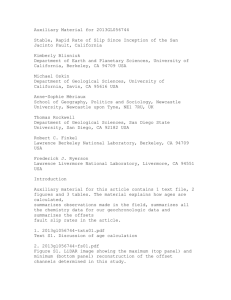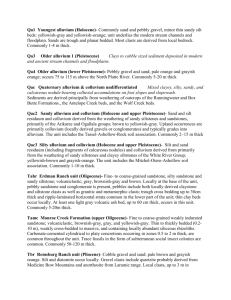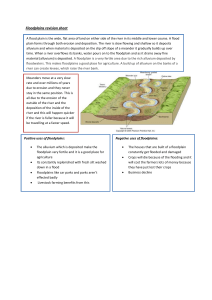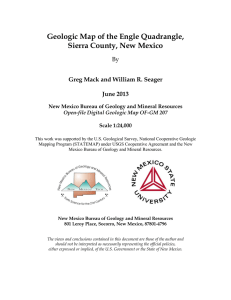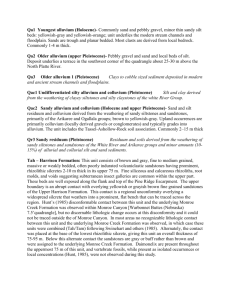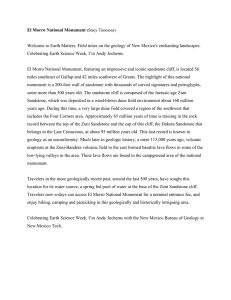Preliminary Geologic Map of the San Rafael Quadrangle, Cibola County, New Mexico
advertisement
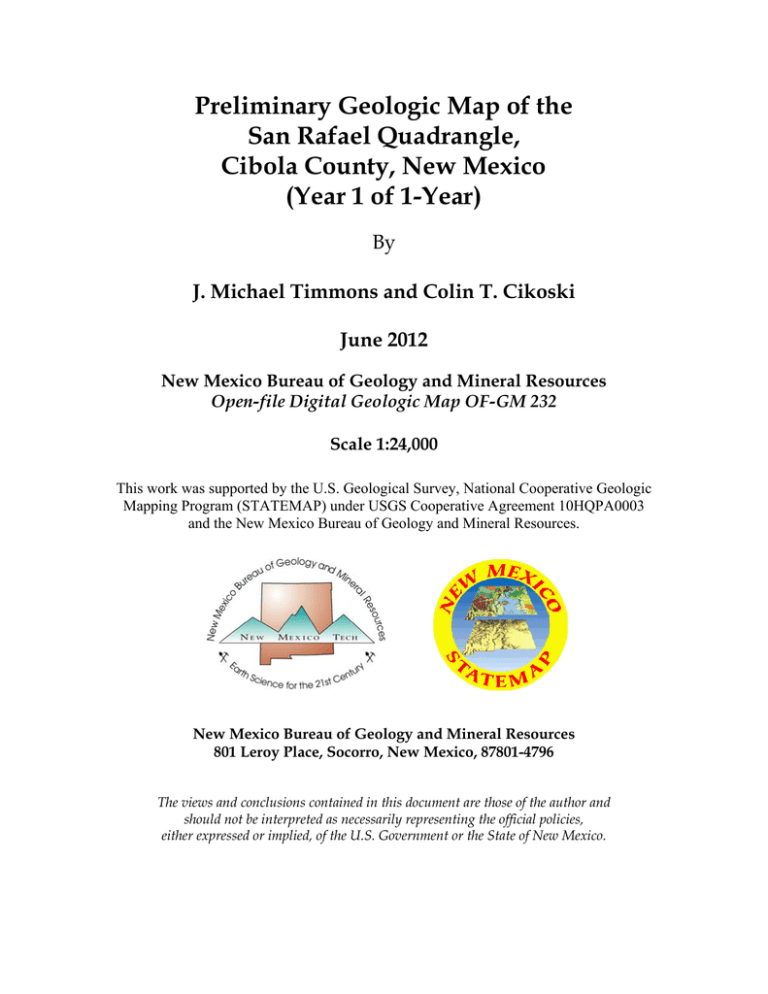
Preliminary Geologic Map of the San Rafael Quadrangle, Cibola County, New Mexico (Year 1 of 1-Year) By J. Michael Timmons and Colin T. Cikoski June 2012 New Mexico Bureau of Geology and Mineral Resources Open-file Digital Geologic Map OF-GM 232 Scale 1:24,000 This work was supported by the U.S. Geological Survey, National Cooperative Geologic Mapping Program (STATEMAP) under USGS Cooperative Agreement 10HQPA0003 and the New Mexico Bureau of Geology and Mineral Resources. New Mexico Bureau of Geology and Mineral Resources 801 Leroy Place, Socorro, New Mexico, 87801-4796 The views and conclusions contained in this document are those of the author and should not be interpreted as necessarily representing the official policies, either expressed or implied, of the U.S. Government or the State of New Mexico. Unit Descriptions Quaternary units (Note – Colors are after Munsell Color (2009) and carbonate horizon stages are after Gile et al. (1965) and Machette (1985).) Alluvium of the Zuni Mountains interior Qa Alluvium of the Zuni Mountain interior, undivided – Sand, silt, and lesser gravel associated with streams within the Zuni Mountains. Typically subdivided based on age and geomorphic characteristics. Undivided unit used for small streams with multiple subunits present. Qaf Active gully-mouth fans – Sand, silt, and rare gravel of historic gully-mouth fans. Fans emanate from present-day arroyos. No soil development. No exposure, but likely up to 1 m thick. Qay Younger interior alluvium – Sand, silt, and gravel of and graded to the current Bonita Canyon floor. West of Bonita Canyon, consists of dark brownish gray silty sand matrix-rich fine granite pebbles, with rare fine-grained mafics and quartzite; colors of 7.5 YR 3/2 to 4/3 were measured. On east side, consists of yellowish red weakly bedded silty sand, with pebbles and cobbles in paleochannels; colors of 5 YR 4/6 to 5/6 were measured. Along Bonita Canyon axis, consists of brown silty sands, with sparse fine pebbles; colors of 5 YR to 7.5 YR 4/4 were measured. 0.5 to 1.5 m thick. Qao Older interior alluvium – Alluvium grading to levels above the current Bonita Canyon floor. Divided into western/axial and eastern map units, due to significant variability in tread heights and characteristics. Qaow Western and axial older alluvium – Reddish brown silty sands with rare to abundant pebbles underlying terrace treads 2-4 m above local streams along and to the west of Bonita Canyon. Axial sediments mainly of massive silty sands with up to Stage I carbonate horizon morphology, with rare thin lenses of pebbles; colors of 5 YR 4/3 to 5/4 were measured. Western sediments mainly granite pebbles with abundant silty sand matrix and no visible carbonate accumulation; a more yellowish color, 5 YR 4/6, was measured. Maximum exposed thickness of 1.1 m, likely at least 4 m thick. Qaoe Eastern older alluvium – Dark to pale reddish brown sands, muds, and gravels underlying terrace treads 5-7 m above local streams tributary to Bonita Canyon from the east. Dominantly of massive clayey silty sands, with paleochannels of pebbles to local boulders of siltstone, quartz sandstone, and rare limestone. Contains at least four buried soils defined by darkened A horizons and/or up to Stage II+ carbonate horizons. Active soil has a Stage III carbonate horizon. 5 YR 4/4 to 6/6 colors were measured in unaltered material. Maximum exposed thickness of 7 m. Qst Strath terraces – Pebbles to boulders of strath terraces overlying bedrock in the Zuni Mountains. Gravels are very poorly sorted and angular, and locally matrixsupported in debris flow bars. Gravel compositions are mainly limestone, with lesser quartz sandstone and red siltstone. No evidence of soil development, but tread projects to that of Qaoe. 0-2 m thick. Qatf Tributary fan alluvium of the interior – Sand, silt, and gravels of small, overlapping alluvial fans tributary to the larger drainages. Used for small fans with no appreciable features separating older and younger alluvium. Mainly younger alluvium at the surface, and includes local colluvium. At least 3 m thick. Alluvium of the Zuni Mountains piedmont Qp Alluvium of the Zuni Mountain piedmont – Sand, silt, and gravel of fans and terraces extending eastward from the Zuni Mountains. Typically subdivided based on sedimentary and geomorphic characteristics. Qpf Active gully-mouth fans - Sand, silt, and rare gravel of historic gully-mouth fans. Fans emanate from present-day arroyos. No soil development. No exposure, but likely up to 1 m thick. Qpy3 Youngest piedmont alluvium – Brown silty fine to coarse sands with little soil development. Includes rare matrix-supported fine pebbles. Typically massive (bioturbated). Contains sparse very fine carbonate nodules, exhibiting up to Stage I carbonate horizon development. Colors of 5 YR 6/4 to 7.5 YR 5/3 were measured. Maximum exposed thickness of 65 cm. Qpy2 Medial young piedmont alluvium – Dark grayish brown fine sandy muds with little soil development. Includes rare, thin lenses of very fine pebbles. Massive (bioturbated). Contains common very fine carbonate nodules and thin veinlets, commonly exhibiting Stage I and locally Stage II carbonate horizon morphology. Colors of 7.5 YR to 10 YR 4/2 were measured. Maximum exposed thickness of 1.1 m. Qpy1 Older young piedmont alluvium – Brown silty fine to coarse sands with little to moderate soil development. Includes sparse matrix-supported pebbles. Typically massive (bioturbated). Contains common very fine carbonate nodules and veinlets, with common Stage I and local Stage II carbonate horizon morphology. Colors of 5 YR 4/3 and 7.5 YR 4/3 were measured. Maximum exposed thickness of 1 m, likely as much as 2 m thick where found at the surface. Qpyt Young piedmont alluvium of the Trail Canyon fan – Boulder- to cobble-rich alluvium emanating from Trail Canyon. Gravels are mainly of limestone with lesser quartz sandstone, decreasing in average size downstream. Matrix material is a brown (7.5 YR 5/4) silty fine to coarse sand. Likely as much as 2 m thick. Qpy Younger piedmont alluvium, undivided – Silty sands and sandy silts with sparse gravels. Used where the younger alluvium subdivisions are not clear. Consists mainly of Qpy2 and Qpy3. Up to 1 m or greater thick. Qpo Older piedmont alluvium – Pale to medium reddish brown pebbles to boulders and silty sands with strong soil development. Very poorly sorted, subangular to subrounded gravels dominantly of limestone, with lesser quartz sandstone and rare pebble conglomerate, as massive tabular bouldery beds by the mountain front, and as pebbles and cobbles in rare channels away from the front. Silty sands are massive (bioturbated), with uncommon to sparse matrix-supported pebbles. Stage III carbonate morphology is common in outcrop. Colors of 5 YR 5/4 to 8.5/2 were measured, with color strongly controlled by abundance of carbonate. Exposed thicknesses from 0 to 5 m, likely as much as 10 m or more thick. Qptf Tributary fan alluvium of the piedmont – Sand, silt, and gravels of small, overlapping alluvial fans tributary to the larger drainages. Used for small fans with no appreciable features separating older and younger alluvium. Mainly younger alluvium at the surface, and includes local colluvium. At least 3 m thick. QTg High-level piedmont gravels – Rounded boulders of limestone overlying Triassic rocks on hill tops. These boulders are interpreted to be the remains of a Pliocene or early Pleistocene terrace or fan deposit that has since been almost entirely removed by erosion. Cover units af Artificial fill – Consolidated sand, silt, clay, and gravel of artificial earthen structures. Dominantly earthen dams. Up to 6 m thick. Qes Eolian sand sheet, undivided – Sands and silts accumulating on the eastern piedmont of the Zuni Mountains. Mapped where obscures underlying alluvial units and bedrock geology. No exposure, but likely as much as 2 m thick. Qsa Slopewash alluvium – Sand and silt with rare pebbles, accumulating along broad shallow channels. Only mapped where expected to be thick or obscuring underlying geology. 0-1 m or more thick. Qca Colluvium and alluvium, undivided – Sand, silt, and gravel accumulating below steep slopes. Only mapped where thick or concealing underlying geologic relationships. 0-2 m or more thick. Qls Landslides – Large blocks and bouldery gravels associated with mass wasting. Likely as much as 30 m thick. Basalt flows Qbp Paxton Springs flow – Dark gray to black blocky flow mainly uncovered by younger fines. Sparse (under 1%) fine (under 1 mm across) anhedral phenocrysts of green olivine and white plagioclase. Common vesicles and amygdules. 0-4 m thick. Qbz Zuni flow - Dark gray to black basalt flow largely concealed by younger fines in Zuni Canyon. Sparse (under 1%) fine (under 1 mm across) green olivine phenocrysts. Typically rare vesicles and amygdules. Unexposed base. Up to perhaps 5 m thick. Qbc El Calderon flow – Dark gray to black basalt flow largely concealed beneath younger eolian fines along the east margin of the quadrangle. Sparse, very fine phenocrysts of olivine. Exact age uncertain, but constrained to 50-130 ka. Base unexposed. Travertine QTtr High-level travertine – Light to medium gray, fine-grained limestone capping Cerrito Colorado. Thinly (1 to 10 cm thick) bedded with planar to wavy beds. Very fine granular texture in matrix, with common white spots up to 2 mm across. As much as 3 m thick. Triassic Strata TRc Chinle Group Undivided – Variegated mudstones and white to pale tan conglomeratic sandstones likely representing attenuated units from bottom to top the Shinarump Formation, Bluewater Creek Formation through the Sonsela Member of the Petrified Forest Formation (after Heckert and Lucas 2003). The lower 15-18 m includes cross-bedded pebbly sandstones, with pebbles of dark gray to brown chert and red to reddish brown mudstones. The basal pebbly sandstone to pebble conglomerate typically forms a prominent ledge overlying soft Moenkopi strata that is visible on aerial imagery and slightly grayer than the underlying redder Moenkopi mudstones. Pebble content within this formation is quite variable and laterally discontinuous. The upper portion of this mapped unit is up to 20 m of pale brown to light gray cross-bedded quartzose sandstones and limestone pebble conglomerates representing the Sonsela Member of the Petrified Forest Formation. Sandstones are thin to medium bedded, with common crossbedding in both sandstones and limestone pebble conglomerates, though more vague in the later. Both occur as tabular beds and channels. Both have carbonate cement. Labeled as TRu in cross section. TRm Moenkopi Formation - Poorly exposed slope-forming unit that isred to reddish brown mudstone and siltstone. Basal mudstones and silty mudstones are generally less than 5 meters thick, weak red to dark red, and weather into low, unvegetated slopes. Overlying silty sandstones are pale red in color, thin- to very thin-bedded, and calcareous. They are moderately sorted, composed of 80% quartz and 20% chert, feldspar, and lithic fragments in medium- to fine-grained, sub-angular to sub-rounded groundmass. Labeled as TRu in cross section. Paleozoic Strata Psa San Andres Formation - Light to dark gray limestone and dolomite. Limestones and dolomites range from thin to thick bedded. Interbedded tan, pinkish tan to very light orange sandstones represent discrete tongues of the underlying Glorieta Sandstone. Sandstones are composed of medium- to fine-grained, rounded to subrounded quartz grains, are non-calcareous, and usually have distinct tabular cross-beds. A prominent sandstone tongue 7 – 8 meters above the Glorieta sandstone, visible in the walls of Zuni Canyon, is locally mappable but pinches out repeatedly. Additional variably discontinuous sandstone lenses are present higher in the section and can be seen in numerous incised valleys throughout the quadrangle. The top of the formation is a regional unconformity, paleokarst development at this unconformity has been reported (Colpitts, 1989). Pg Glorieta Formation - White to pale orange to grayish-pink quartz sandstone. The sandstone is dominantly medium to large bedded quartz arenite, with well rounded to sub rounded grains, and well sorted. The sandstone is at least 30 m thick and as much as 60 m thick as reported by Colpitts (1989). The formation intertongues with the overlying San Andres Formation and is gradational with the underlying Yeso Formation. The top of the formation is marked by the first occurance of carbonate beds of the San Andres Formation. Py Yeso Formation – Reddish orange to light brown quartz sandstone with interbedded yellowish gray to grayish brown, medium to thin bedded carbonate beds. Associated with the carbonate beds are medium thick beds of gypsum. Sandstone deposits are fine to very fine grained and vary from relatively angular to sub angular grains to moderately rounded to well rounded grains. Sandstones consist of thin-to thick planar tabular beds. The entire section is exposed at Gallo Peak and is subdivided into 3 members including from bottom to top, the Meseta Blanca, Torres, and Joyita Members. Colpitts (1989) reports a total thickness for the formation at Gallo Peak of about 380 meters. Pa Abo Formation – A mixed siliciclastic formation composed of reddish brown mudstones, reddish brown siltstones, grayish red sandstones, and pale to moderate redish brown conglomeratic beds. Sandstone beds are moderately sorted with angular to sub-rounded grains and grain size ranges from course to very fine grained. Sandstone beds are moderately to thick bedded. Conglomeratic beds are composed of pebble to granule clasts in a medium to very fine grained sandstone. Conglomeratic beds are discontinuous and form channels at the base of some sandstone beds (Colpitts, 1989). lPb Bursum Formation – Originally lumped with the basal Abo Formation (Colpitts, 1989), this formation is now assigned to the Oso Ridge Member of the Bursum Formation (Krainer et al, 2003) and consists of light pink to redish brown lithic arenite conglomerates, and light gray limestone. Conglomeratic beds are very immature with very angular clasts, poorly sorted, and almost exclusively derived from the underlying Proterozoic metamorphic rocks. Conglomerate beds are laterally discontinuous and tend to infill paleotopography on the metamorphic rocks. Carbonate beds tend to be thin bedded carbonate mudstone and wackestone to medium bedded fossiliferous wackestones. Fossil assemblages indicates a Virgilian age for these beds (Krainer et al., 2003). Proterozoic Rocks Xgg – Granitic Gneiss – Foliated calc-alkaline granitoids that make up most of the exposed metamorphic rocks in the Zuni Mountains. The granitoids are dominately quartz monzanites (Strickland et al., 2003) and yield an age of 1655 Ma (Bowring and Condie, 1982). Deformation within these rocks are characterized by a penetrative foliation and an associated stretching lineation (Strickland et al., 2003). Within the map area foliations strike NW and dip steeply to the SW. References Bowring, S. A. and Condie, K. C., 1982, U-Pb Zircon Ages from Northern and Central New Mexico: Geological Society of America Abstarcts with Programs, v. 14, p. 304. Colpitts, R. M., 1989, Permian Reference Section for southeastern Zuni Mountains, Cibola County, New Mexico: in Anderson et al. eds., Southeastern Colorado Plateau, Geological Society Guidebook, 40th Field Conference, pp 177-180. Gile, L.H., Peterson, F.F., and Grossman, R.B. 1965. The K horizon - a master soil horizon of carbonate accumulation. Soil Science 99, p. 74-82. Heckert, A. B. and Lucas, S. G., 2003, Triassic Stratigraphy in the Zuni Mountains, West-Central New Mexico: in Lucas et al. eds., Geology of the Zuni Plateau, Geological Society Guidebook, 54th Field Conference, pp 245-262. Krainer, K. Lucas, S. G., Kues, B. S., 2003, Upper Pennsylvanian Strata in the Zuni Mountains, West-Central New Mexico, in Lucas et al. eds., Geology of the Zuni Plateau, Geological Society Guidebook, 54th Field Conference, pp 219-229. Machette, M.N. 1985. Calcic soils of the southwestern United States. Geological Society of America Special Paper 203, p. 1-21. Munsell Color. 2009. Munsell soil-color charts, 2009 edition. Munsell Color, Grand Rapids, MI. Strickland, D., Heizler, M. T. Selverstone J. and Karlstrom, K. E., 2003, Proterozoic evolution of the Zuni Mountains, Western New Mexico: Relationship to the Jemez Lineament and implications for a complex cooling history, New Mexico: in Lucas et al. eds., Geology of the Zuni Plateau, Geological Society Guidebook, 54th Field Conference, pp 109-117. QUATERNARY GEOLOGY The Quaternary sediments on the San Rafael quadrangle are subdivided based on sedimentary, geomorphic, and pedogenic characteristics, and locally includes intercalated middle-late Pleistocene basalt flows. Alluvium of the Zuni Mountain interior is kept separate from the alluvium of the Zuni Mountain piedmont due to uncertainty in unit correlation and a more diverse set of units in the piedmont. In a broad sense, alluvium of the Zuni Mountain interior consists of Holocene fans and terraces graded to the present Bonita Canyon floor and Pleistocene units graded to a level 2-3 m above the present canyon floor. Holocene alluvial units (Qay) exhibit only weak soil development characterized by moderately well-developed soil structure but little carbonate accumulation and no discernible reddening or clay illuviation. They are dominantly fine-grained, with silty sand or sandy silt textures, with locally common gravel-rich paleochannels along tributary streams, but only sparse and thin gravel channels along the Bonita Canyon axis. Granite pebbles are common in sediments from the west side of the canyon, while less abundant pebbles to cobbles of red siltstone, light gray to beige quartz sandstone, and limestone are found in the sediments from the east. Older alluvium is generally sedimentologically like the younger alluvium, with variable amounts of soil development. The best exposures of older alluvium occur on the east side of the canyon, where incision up to 7 m below the tread of the older alluvium (Qaoe) exposes a flight of at least four buried soils and a Stage III carbonate horizon at the top of the deposit (carbonate stages after Gile et al., 1965, and Machette, 1985). The welldeveloped soil at the top of the unit indicates a middle(?) Pleistocene age for the unit (cf., Gile et al., 1981; Goff et al., 2008). Along the axis of Bonita Canyon and along tributary streams from the west, the older alluvium (Qaow) tread is only inset upon by up to 4 m by local streams. Neither the upper well-developed soil nor the flight of buried soils have been found in outcrop for the axial and western older alluvium, but the tread heights for all older alluvium appear to project to the same level, suggesting they are age-correlative. A strath terrace (Qst) of comparable tread height to the eastern older alluvium fan continues up several of the eastern tributary streams, overlying soft, red siltstone bedrock with angular unconformity. Although the sediments of the older and younger alluvium are similar, they can usually be differentiated in outcrop based on the redder color, stiffer consistence, and presence of buried soils in the older alluvium. Several hills and ridges of bedrock along Bonita Canyon have similar heights above the canyon floor, suggesting they belong to a dissected pediment surface, possibly of Pliocene age. We examined several of these hill tops in the field, however, and found no clearly transported clasts to confirm the presence of a pediment. The alluvium of the piedmont of the Zuni Mountains is divided into four Holocene units, one Pleistocene unit, and one Plio-Pleistocene unit. The youngest and oldest Holocene units (Qpy3 and Qpy1, respectively) are sedimentologically similar, with both consisting of brown silty sands with matrix-supported pebbles; they are typically distinguished from each other by the presence of the middle Holocene unit (Qpy2) and by the more abundant fine carbonate nodules and veinlets, slightly lighter color, and more abundant coarse pebbles and cobbles in the older Qpy1. Where Qpy1 is at the surface, it also stands slightly higher, by 0.5 to 1 m, than surrounding Qpy2 and Qpy3 units. The medial Holocene unit, Qpy2, is a dark grayish brown color and finer-grained than the other two Holocene units, consisting mainly of sandy silts and clays. The weak soil development seen in each of these units suggests Holocene ages, although Qpy1 may be late Pleistocene. A fourth, particularly coarse Holocene unit (Qpyt) is found at the mouth of Trail Canyon filling broad braided channels. These deposits bear relatively common cobbles and boulders, up to 1.5 m across, of limestone and quartz sandstone, and grade down-gradient into deposits of Qpy3 and Qpy2. The (middle?) Pleistocene piedmont unit (Qpo) is typically readily distinguished by its better developed carbonate horizons (Stage III morphology typical) and redder colors. It consists dominantly of silty sands, but with relatively large paleochannels of pebbles and cobbles not seen in the younger units. Near the mouth of Trail Canyon, the unit is readily distinguishable by the presence of abundant boulders of limestone along terrace risers. Fan treads are 4 to 6 m above local channels. Mesozoic mudstones and sandstones locally crop out along the floors of arroyos, constraining the maximum thickness of piedmont alluvium. Isolated, rounded boulders of limestone found capping a hill of Triassic rocks west-southwest of Atarque del Doter in the east-central of the quadrangle are interpreted as the remains of a Pliocene or early Pleistocene piedmont deposit (QTg). Later erosion has removed the finer components of the deposit, leaving only the isolated boulders behind. Piedmont alluvial units are variably buried by a Quaternary sand sheet (Qes) that becomes increasingly prevalent eastward away from the mountains. The contact is placed where the alluvial units can no longer be differentiated. Three Pleistocene basalt flows are present on the quadrangle intercalated with the alluvial units (in order of increasing age): the Paxton Springs (Qbp), Zuni (Qbz), and El Calderon (Qbc) flows of Maxwell (1986). The youngest of these, the Paxton Springs flow, emanated from centers within the Zuni Mountains approximately 4 mi to the southwest of the exposures on this quadrangle (Maxwell, 1986). These flows are largely unconcealed by younger fine-grained sediment, and Dunbar and Phillips (2004) obtained a Cl-36 surface exposure age of 20.7 ± 2.2 ka for this flow (their “Paxton Springs north”). Maxwell interpreted the Paxton Springs flow to continue down Zuni Canyon to terminate in a broad lobe of basalt between the towns of Grants and San Rafael. This interpretation likely resulted from the character of the basalt between these towns, which is largely unconcealed by fine-grained sediment, like the flows around Paxton Springs. However, the basalt that is found along most of Zuni Canyon is largely concealed beneath younger sediment, similar to the Zuni flows, which emanated from the Cerro Colorado vent, approximately 3.5 mi to the northwest of the northwest corner of the quadrangle (Maxwell, 1986). In fact, Laughlin et al. (1972) interpreted the Zuni flows to have continued down Zuni Canyon to the area between Grants and San Rafael, and not the Paxton Springs flow. We do not know of any study conclusively demonstrating which flow is found along Zuni Canyon or is present in the area between the two towns, but suggest that it is the Zuni flow, based on similar degrees of concealment by younger sediment. This flow has not been geochemically dated, but underlies the Paxton Springs flow in the northwest corner of the quadrangle, and overlies the El Calderon flow in the area of Grants. The older El Calderon flow occurs along the eastern margin of the quadrangle and emanated from the area of El Calderon (Maxwell, 1986), approximately 3 miles southwest of the southwest corner of the quadrangle. Several attempts to date the El Calderon flow have been made, but the results are imprecise. Laughlin et al. (1993) obtained a K-Ar age of 54 ± 50 ka, while Champion and Lanphere (1988) obtained an age of 128 ± 33 ka. Although these ages are not particularly close to one another, they are within error, with an average of 91 ka. Based on these ages and paleomagnetic data, however, Cascadden et al. (1997) suggested the flow erupted during the 115 to 120 ka Blake geomagnetic polarity event of Tric et al. (1991). Dunbar and Phillips (1994), meanwhile, obtained a Cl-36 surface exposure age of 33.4 ± 3 ka for the flow, but this appears to be too young. Also potentially of Quaternary age on the quadrangle is a travertine deposit found capping Cerrito Colorado in the north central of the quad. The travertine is readily distinguished here by the presence of Triassic sediments between it and the underlying San Andreas Limestone. The travertine is thinly bedded, with planar to wavy beds, and bears a very fine granular texture in the matrix. The exposure at the top of Cerrito Colorado is subhorizontal and interpreted as in place; several outcrops are also found below the top but with shallow to moderate dip angles, typically dipping toward the hill, and these we interpret to be rotated slump blocks (Toreva blocks). The exact age of the travertine is unknown, but its geographic position, high in the landscape, suggests a late Tertiary or early Pleistocene age. References Cascadden, T.E., Geissman, J.W., Kudo, A.M., and Laughlin, A.W., 1997, El Calderon cinder cone and associated basalt flows: in Maberry, K., ed., Natrual history of El Malpais National Monument, New Mexico Bureau of Geology and Mineral Resources, Bulletin 156, pp. 41-51. Champion, D.E. and Lanphere, M.A., 1988, Evidence for a new geomagnetic reversal from lava flows in Idaho – discussion of short polarity reversals in the Brunhes and late Matuyama polarity chrons: Journal of Geophysical Research, v. 93, pp. 11,667-11,680. Dunbar, N.W. and Phillips, F.M., 1994, 36Cl surface exposure determinations of eruption ages for Quaternary flows of the Zuni-Bandera volcanic field (abs.): Proceedings Volume, 1994 Annual Spring Meeting, New Mexico Geological Society, p. 34. Dunbar, N.W. and Phillips, F.M., 2004, Cosmogenic 36Cl ages of lava flows in the ZuniBandera volcanic field, north-central New Mexico, USA: in Cather, S.M., McIntosh, W.C., and Kelley, S.A., eds., Tectonics, geochronology, and volcanism in the southern Rocky Mountains and Rio Grande rift, N.M. Bureau of Geology and Mineral Resources, Bulletin 160, pp. 309-317. Gile, L.H., Peterson, F.F., and Grossman, R.B., 1965, The K horizon: a master soil horizon of carbonate accumulation: Soil Science 99, pp. 74-82. Gile, L.H., Hawley, J.W., and Grossman, R.B., 1981., Soils and geomorphology in the Basin and Range area of southern New Mexico - Guidebook to the Desert Project: New Mexico Bureau of Mines and Mineral Resources Memoir 39, 222 pp. Goff, F., Kelley, S.A., Zeigler, K.E., Drakos, P. and Goff, C.J., 2008, Preliminary geologic map of the Lobo Springs quadrangle, Cibola County, New Mexico: New Mexico Bureau of Geology and Mineral Resources, OFR 181, 1:24,000, color. Laughlin, A.W., Brookins, D.G., and Causey, J.D., 1972, Late Cenozoic basalts from the Bandera lava field, Valencia County, New Mexico: Geological Society of America Bulletin, v. 83, pp. 1543-1551. Laughlin, A.W., Perry, F.V., Damon, P.E., Shafiqullah, M., WoldeGrabriel, G., McIntosh, W.C., Harrington, C.D., Wells, S.G., and Drake [Drakos], P.D., 1993, Geochronology of Mount Taylor, Cebollita Mesa, and Zuni-Bandera volcanic fields, Cibola County, New Mexico: New Mexico Geology, v. 15, pp. 81-92. Machette, M.N., 1985, Calcic soils of the southwestern United States: Geological Society of America Special Paper 203, pp. 1-21. Maxwell, C.H., 1986, Geologic map of El Malpais lava field and surrounding areas, Cibola County, New Mexico: US Geological Survey, Miscellaneous Investigations Map I-1595, scale 1:62,500. Tric, E., Laj, C., Valet, J.P., Tucholka, P., Paterne, M., and Gichard, F., 1991, The Blake geomagnetic event: transitional geometry, dynamical characteristics and geomagnetic significance: Earth Planetary Science Letters, v. 102, pp. 1-13.
